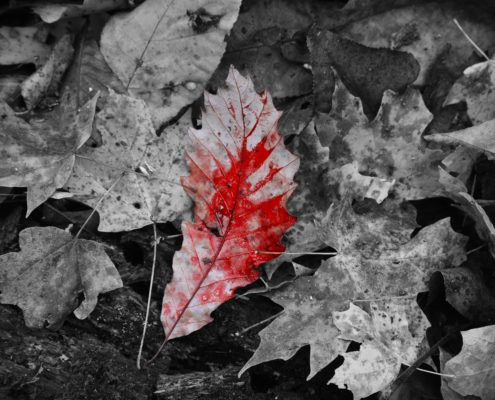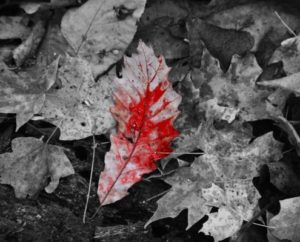
24 Nov BLOODED!!!

Not every shot ends well. An unseen stick can deflect the shot. A last second flinch by the shooter or critter will change the point of impact. Sadly, the deer may be wounded and must be tracked.
Following a Blood Trail is an often undiscussed but an exciting part of the hunt that requires learned skills. Not every hunter is a good tracker here are some thoughts and ideas that will make you better at tracking.
During one woodland hunt, I was still hunting up a valley. Off to my right I saw a buck looking at me head on. He had seen me and was perfectly still at 100 yards. It was black powder season and I was shooting a 50 caliber Hawken muzzle loader with iron sites. I took aim on the center of the buck’s chest. This is a shot I rarely take but I was confident with my skills. My aim was helped by a tree limb and I took the shot. The buck turned and ran out of sight. I carefully marked the spot of the shot and the last place I saw the buck.
When I got the place where the buck stood, there was no blood! No way I missed, I thought. I saw some kicked up leaves and was able to track the movement of the buck but still had no blood. Next, I went to the spot where I last saw the buck run off after the shot. 10 yards from the spot lay my buck! The shot was dead center in the chest. The 50-caliber slug passed through the lungs, liver, and stopped at the rear ham. It rested just under the skin. No blood had come out of the deer. It wasn’t until I field dressed the buck that I discovered it had bled internally. The cavity was full of blood. Follow up every shot that you take.
After the shot Watch the critter. Look for behavior that indicates a wound. Mark the first and final positions of your target.
Wait, watch, and listen There is no hurry. If you made your one best shot, observe to see the outcome. Use your optics to scan for movement or the fallen critter. Take a compass bearing from your stand. Mark the two positions. Travel to the position of your shot and look for sign. Hopefully you will find hair, blood, and sign. Mark the sign with a ribbon and begin to track it out.
Examine the last place you saw the critter. With luck, you are on a blood trail or have tracks and trail to follow. Scan ahead looking for a fallen critter or movement. You may also hear sounds. Use all your senses to help find the deer.
Back out if it is getting dark and you have no sign. Mark the last spot with a ribbon so you can return with help.
Examine the evidence If you have hair and blood, evaluate where you hit the deer.
Blood color will tell a lot Bright bubbly blood means a lung shot. Dark blood with debris in it means a gut shot. Dark clean blood means a liver hit. Are there bone chips in the blood trail, Rib pieces, leg bones. Understand the anatomy. Is the blood on the ground, right tor left of the main trail, high on twigs or leaves? This will tell you where the critter is bleeding from. If blood in in the footprint, it is dripping down the leg. Evaluate what you see.
If the deer is continually moving, slow down. Look for places where the deer stood or bedded. Allow the wound to do the job and let the deer relax, stiffen up and die. If you push it harder, the deed will get more adrenaline and ca quickly clot. It may then move leaving little or nor blood trail.
If you lose the trail Start making circles from the last blood sign. Mark the spots with ribbon so you can guess a path. Hard hit deer seldom go up hill or through thick cover. They also are losing fluids, so thirst is a factor. Wounded deer will travel to a water source. Be sure to search these areas.
Two trailers are enough. The more company, the more chance you have of ruining a limited trail. Flag every drop or bit of sign as you go. Slow and thorough tracking is important. Communicate and ask questions like, where would he go?” Is he walking, limping, or running? Where is the closest water source? Where would this buck bed? Read the sign and make a plan.
Tracking at night A Coleman Lantern will help you see a blood trail. The wet blood will reflect the light. Other Blue light or heat sensor tracking lights can be useful. Some dogs are good at tracking a blood trail. If you are not sure you are seeing blood drops, pray hydrogen peroxide onto the spot. If it fizzes, its blood.
If all else fails and you are sure that the deer was head, take a break. Get some additional help and lay out a grid. In most cases the mortally wounded deer is usually within a few hundred yards of where it was hit. Start in this area. If the deer went further, there is a good chance it may survive the wound. Once you have exhausted every hope of retrieving a deer, start looking for ravens and scavengers. This may happen weeks later. Use your nose to smell a dead critter. You may at least put an end to the mystery and retrieve the antlers.
Deer can sustain huge damage. They clot quickly and heal fast. I have seen lost deer weeks later chasing does in a field. Harvested deer have also been found to carry slugs and broadheads for years. Nature finds a way.
Be the BEST hunter you can be! Make every trigger pull your one best shot!
Montana Grant
For more Montana Grant, aim for him at www.montanagrantfishing.com.


